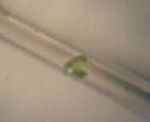- Compounds of californium
-
Few compounds of californium have been made and studied.[1] The only californium ion that is stable in aqueous solutions is the californium(III) cation.[2] The other two oxidation states are IV (strong oxidizing agents) and II (strong reducing agents).[3] The element forms a water-soluble chloride, nitrate, perchlorate, and sulfate and is precipitated as a fluoride, oxalate or hydroxide.[4] If problems of availability of the element could be overcome, then CfBr2 and CfI2 would likely be stable.[5]
The +3 oxidation state is represented by californium(III) oxide (yellow-green, Cf2O3), californium(III) fluoride (bright green, CfF3) and californium(III) iodide (lemon yellow, CfI3).[3] Other +3 oxidation states include the sulfide and metallocene.[6] Californium(IV) oxide (black brown, CfO2), californium(IV) fluoride (green, CfF4) represent the IV oxidation state. The II state is represented by californium(II) bromide (yellow, CfBr2) and californium(II) iodide (dark violet, CfI2).[3]
Compounds
Californium(IV) oxide (CfO2) is a black-brown solid that has a cubic crystal structure with a lattice parameter, the distance between unit cells in the crystal, of 531.0 ± 0.2 pm.[7] Crystals of californium(III) oxide normally have a body-centered cubic symmetry. They convert to a monoclinic form upon heating to about 1400 °C and melt at 1750 °C.[7]
Californium(III) chloride (CfCl3) is an emerald green compound with a hexagonal structure that can be prepared by reacting Cf2O3 with hydrochloric acid at 500 °C.[8] CfCl3 is then used as a feeder stock to form the yellow-orange triiodide CfI3, which in turn can be reduced to the lavender-violet diiodide CfI2.[9]
Californium(III) fluoride (CfF3) is a yellow-green solid with a crystal symmetry that gradually changes from orthorhombic to trigonal when heated above room temperature.[10] Californium(IV) fluoride (CfF4) is a bright green solid with a monoclinic crystal structure.[11]
Californium(II) iodide (CfI2) is a deep purple solid with a stable rhombohedral structure at room temperature and an unstable hexagonal structure. Californium(III) iodide (CfI3) is a lemon-yellow solid that has a rhombohedral structure and sublimes at ~800 °C.[12]
Californium(III) oxyfluoride (CfOF) is prepared by hydrolysis of californium(III) fluoride (CfF3) at high temperature.[13] Californium(III) oxychloride (CfOCl) is prepared by hydrolysis of the hydrate of californium(III) chloride at 280–320 °C.[14]
Heating the sulfate in air at about 1200 °C and then reducing with hydrogen at 500 °C produces the sesquioxide (Cf2O3).[8] The hydroxide Cf(OH)3 and the trifluoride CfF3 are slightly soluble.[8]
Californium(III) oxychloride (CfOCl) was the first californium compound ever discovered.[15]
References
- ^ Krebs, Robert (2006). The History and Use of our Earth's Chemical Elements: A Reference Guide. Westport, Connecticut: Greenwood Publishing Group. pp. 327–328. ISBN 978-0-313-33438-2.
- ^ CRC 2006, p. 4-8.
- ^ a b c Jakubke 1994, p. 166.
- ^ Seaborg 2004.
- ^ Greenwood 1997, p. 1272.
- ^ Cotton 1999, p. 1163.
- ^ a b Baybarz, R. D.; Haire, R. G.; Fahey, J. A (1972). "On the Californium Oxide System". Inorganic and Nuclear Chemistry 34 (2): 557–565. doi:10.1016/0022-1902(72)80435-4.
- ^ a b c Cunningham 1968, p. 105.
- ^ Cotton, Simon (2006). Lanthanide and Actinide Chemistry. West Sussex, England: John Wiley & Sons. p. 168. ISBN 047001005. http://books.google.com/?id=SvAbtU6XvzgC&lpg=PP1&dq=Lanthanide%20and%20Actinide%20Chemistry&pg=PP1#v=onepage&q.
- ^ Stevenson, J. N; Peterson, J. R. (1973). "The Trigonal and Orthorhombic Crystal Structures of CfF3 and their Temperature Relationship". Inorganic and Nuclear Chemistry 35 (10): 3481–3486. doi:10.1016/0022-1902(73)80356-2.
- ^ Chang, C-T. P.; Haire, R. G.; Nave, S. E. (1990). "Magnetic Susceptibility of Californium Fluorides". Physical Review B 41 (13): 9045–9048. Bibcode 1990PhRvB..41.9045C. doi:10.1103/PhysRevB.41.9045.
- ^ Macintyre, J. E.; Daniel, F. M.; Stirling, V. M. (1992). Dictionary of inorganic compounds. London: Chapman and Hall, CRC Press. p. 2826. ISBN 978-0-412-30120-9.
- ^ Peterson, J. R.; Burns, John H. (1968). "Preparation and Crystal Structure of Californium Oxyfluoride, CfOF". Inorganic and Nuclear Chemistry 30 (11): 2955–2958. doi:10.1016/0022-1902(68)80155-1.
- ^ Copeland, J. C.; Cunningham, B. B. (1969). "Crystallography of the Compounds of Californium. II. Crystal Structure and Lattice Parameters of Californium Oxychloride and Californium Sesquioxide". Inorganic and Nuclear Chemistry 31 (3): 733–740. doi:10.1016/0022-1902(69)80020-5.
- ^ Seaborg, Glenn T. (1963). Man-Made Transuranium Elements. Prentice-Hall.
Bibliography
- Cotton, F. Albert; Wilkinson, Geoffrey; Murillo, Carlos A.; Bochmann, Manfred (1999). Advanced Inorganic Chemistry (6th ed.). New York City: John Wiley & Sons. ISBN 0-471-199957-5.
- CRC contributors (2006). David R. Lide. ed. Handbook of Chemistry and Physics (87th ed.). Boca Raton, Florida: CRC Press, Taylor & Francis Group. ISBN 0-8493-0487-3.
- Cunningham, B. B. (1968). "Californium". In Clifford A. Hampel. The Encyclopedia of the Chemical Elements. New York City: Reinhold Book Corporation. LCCN 68-29938.
- Greenwood, N. N.; Earnshaw, A. (1997). Chemistry of the Elements (2nd ed.). Oxford, England: Butterworth-Heinemann. ISBN 0-7506-3365-4.
- Jakubke, Hans-Dieter; Jeschkeit, Hans, eds (1994). Concise Encyclopedia Chemistry. trans. rev. Eagleson, Mary. Berlin: Walter de Gruyter. ISBN 3110114518. http://books.google.com/books?id=Owuv-c9L_IMC&printsec=frontcover.
- Seaborg, Glenn T. (2004). "Californium". In Geller, Elizabeth. Concise Encyclopedia of Chemistry. New York City: McGraw-Hill. p. 94. ISBN 0-07-143953-6.
Categories:
Wikimedia Foundation. 2010.

